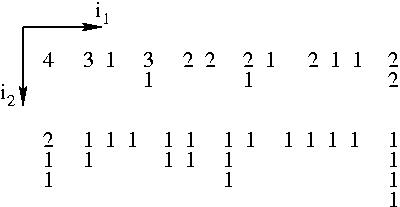| Linear partitions |
A 1-dimensional or linear partition of an integer
is a decomposition
into a sum of positive integers in which
the summands are ordered from
largest to smallest. For instance, the linear partitions of 5 are
5 = 4 + 1 = 3 + 2 = 2 + 2 + 1 = 2 + 1 + 1 + 1 = 1 + 1 + 1 + 1 + 1.
|
| Plane partitions |
A 2-dimensional or plane partition of an integer is a
decomposition
into a sum of smaller positive integers which are
arranged on a plane. The ordering property generalises to the summands
being non-increasing along both the rows and the columns. The plane partitions
of 4 are shown below.

|
| Higher dimensional partitions. |
Now, the summands are arranged on a d-dimensional
hyper-cubic lattice.
The ordering property generalises to the summands
being non-increasing along all the lattice directions.
The 3-dimensional partitions are also known as solid partitions
|
| An enumeration problem. |
How many ways can one partition an integer?
The answer (for the generating function) is known for linear partitions
and plane partitions. But nothing
much is known about higher dimensions.
|
| What I have been looking at. |
| Using exact enumeration and monte carlo methods,
Ville Mustonen
and I calculated numerically the asymptotic behaviour of
solid partitions of an integer. We showed that an old conjecture of
P.A.MacMahon could give the right asymptotic behaviour
(paper). We also enumerated
all solid partitions for integers up to 50 (list).
Currently I am working on a simple combinatorial proof for the MacMahon
formula for plane partitions.
|
| References |
Two references that are easily accessible to physicists:
1. G .E. Andrews 1976 The Theory of Partitions,
Encyclopedia of Mathematics and its Applications Vol 2
(Addison-Wesley, Reading)
2. R. P. Stanley 1999 Enumerative Combinatorics, Vol.
2 (Cambridge University Press, Cambridge)
|
